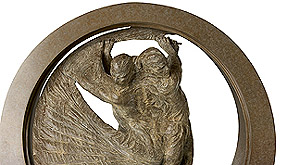Museum Moment: A Monument to the 100th U.S. Open
April 1, 2010
By David Normoyle
The 100th U.S. Open at Pebble Beach Golf Links in 2000 featured a monumental performance by Tiger Woods, who won by a major-championship-record 15 strokes. It also featured the debut of a monument of a more traditional sort.
“Momentum” by California sculptor Richard MacDonald, a 15-foot-tall, 15-ton bronze sculpture, was commissioned for Pebble Beach’s fourth U.S. Open, to commemorate both the U.S. Open and the new millennium.
In 1999, MacDonald created a sculpture of Samuel F. B. Morse, the founder of Pebble Beach, that stands behind the first tee. MacDonald was a friend of John Chadwell, the former president of the Pebble Beach Company, and the idea for an enduring
 |
Located on the Peter Hay Golf Course at Pebble Beach, “Momentum” was a central feature of the 2000 U.S. Open spectator village and will play a similar role for the 2010 championship.
The sculpture represents the skill, athleticism and grace of the complete golf swing. It contains the name of every U.S. Open champion from 1895-1999, with a special plaque reserved for Woods as the 2000 champion. The sculpture has recently been updated to include the names of the U.S. Open champions from 2001-2009 and will bear the names of future champions.
In 1996, MacDonald earned significant acclaim for his 26-foot, 3-ton bronze sculpture of a gymnast called “The Flair,” which was donated to the city of Atlanta and the state of Georgia to commemorate the 1996 Atlanta Olympic Games. He has worked as both a sculptor and an illustrator for major corporations and notable American icons, in addition to a show with the performance group Cirque de Soleil.
Following the 2000 U.S. Open, MacDonald created a limited number of studies of his massive “Momentum” sculpture. Scaled down from 15 feet in height to two feet, the study is still substantial in its heft and weight. In June 2001, MacDonald donated one of his limited-edition studies to the USGA Museum, where it is on display in the new Arnold Palmer Center for Golf History.
According to MacDonald, this work celebrates the triumph of the human spirit and pays tribute to the greatest athletes of the century. The complete circle of the golf swing is meant to coincide with the dawn of a new millennium.
The USGA Museum maintains more than 70,000 artifacts in its collection, with a special emphasis on golf sculpture and decorative arts through the ages. Given its connection with a historic USGA championship, MacDonald’s “U.S. Open Study II” is one of the most highly-valued pieces of sculpture in the Museum’s vast collection.
David Normoyle is the assistant director of the USGA Museum. Contact him with questions or comments at dnormoyle@usga.org.
